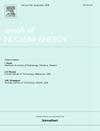球床反应器的敏感性和不确定性分析——基于高温代码包(HCP)的研究
IF 1.9
3区 工程技术
Q1 NUCLEAR SCIENCE & TECHNOLOGY
引用次数: 0
摘要
高温代码包(HCP)为高温气冷堆(htgr)提供了先进的建模和仿真工具。然而,尽管有这种能力,HCP目前缺乏不确定度量化(UQ)和敏感性分析(SA)的综合方法。本研究旨在通过利用DAKOTA工具包和Python库在HCP中实现一个统计框架,从而使UQ/SA工作流能够评估不确定性如何影响HTGR系统的性能。DAKOTA提供了最先进的采样和分析方法,这些方法与HCP的稳态和瞬态多物理场模拟环境相结合。在这项研究中,对HTR-200反应堆设计的稳态和瞬态多物理场进行了UQ分析。结果表明,HTR-200模型在与进口气体温度、质量流量和反应堆功率相关的输入不确定性下表现出稳健的性能,并且兴趣量(qoi)的变化保持在预期的公差范围内。全球SA是加压强迫对流损失(PLOFC)场景和燃料耗尽案例的主要焦点,以进一步探讨关键参数的影响。利用高斯过程仿真器作为HCP的替代模型,采用主成分分析方法降低时间序列数据的维数,有效地计算出Sobol敏感性指数。结果发现,反应堆功率是对PLOFC响应影响最大的参数,而外卵石半径和UO2密度对燃料耗尽和中子密度的影响最为显著。本文章由计算机程序翻译,如有差异,请以英文原文为准。
Sensitivity and uncertainty analysis in pebble-bed reactors: A study using the High-Temperature Code Package (HCP)
The High Temperature Code Package (HCP) provides advanced modeling and simulation tools for High-Temperature Gas-Cooled Reactors (HTGRs). However, despite its capabilities, HCP currently lacks integrated methods for Uncertainty Quantification (UQ) and Sensitivity Analysis (SA). This research aims to implement a statistical framework within HCP by leveraging the DAKOTA toolkit and Python libraries, thereby enabling UQ/SA workflows to evaluate how uncertainties influence the performance of HTGR systems. DAKOTA provides state-of-the-art sampling and analysis methods, which are integrated with HCP’s steady-state and transient multiphysics simulation environments. In this study, a UQ analysis was conducted for both steady-state and transient multiphysics scenarios for a the HTR-200 reactor design. Results demonstrate that the HTR-200 model exhibits robust performance under input uncertainties related to inlet gas temperature, mass flow rate, and reactor power, with variations in Quantities of Interest (QoIs) remaining within expected tolerances. A global SA was the primary focus for a Pressurized Loss of Forced Convection (PLOFC) scenario and a fuel depletion case to further explore the influence of key parameters. An innovative strategy was employed to efficiently compute Sobol sensitivity indices for time-dependent QoIs by using a Gaussian process emulator as a surrogate model for HCP, alongside principal component analysis to reduce the dimensionality of time-series data. The results identified reactor power as the most influential parameter for the PLOFC response, while the outer pebble radius and UO2 density were found to have the most significant impact on fuel depletion and neutron population.
求助全文
通过发布文献求助,成功后即可免费获取论文全文。
去求助
来源期刊

Annals of Nuclear Energy
工程技术-核科学技术
CiteScore
4.30
自引率
21.10%
发文量
632
审稿时长
7.3 months
期刊介绍:
Annals of Nuclear Energy provides an international medium for the communication of original research, ideas and developments in all areas of the field of nuclear energy science and technology. Its scope embraces nuclear fuel reserves, fuel cycles and cost, materials, processing, system and component technology (fission only), design and optimization, direct conversion of nuclear energy sources, environmental control, reactor physics, heat transfer and fluid dynamics, structural analysis, fuel management, future developments, nuclear fuel and safety, nuclear aerosol, neutron physics, computer technology (both software and hardware), risk assessment, radioactive waste disposal and reactor thermal hydraulics. Papers submitted to Annals need to demonstrate a clear link to nuclear power generation/nuclear engineering. Papers which deal with pure nuclear physics, pure health physics, imaging, or attenuation and shielding properties of concretes and various geological materials are not within the scope of the journal. Also, papers that deal with policy or economics are not within the scope of the journal.
 求助内容:
求助内容: 应助结果提醒方式:
应助结果提醒方式:


